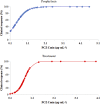Dose Optimisation of Posaconazole and Therapeutic Drug Monitoring in Pediatric Patients
- PMID: 35517786
- PMCID: PMC9061949
- DOI: 10.3389/fphar.2022.833303
Dose Optimisation of Posaconazole and Therapeutic Drug Monitoring in Pediatric Patients
Abstract
Experience in the clinical use of posaconazole (PCZ) in pediatric patients is limited, and no specific dose recommendations exist. This study aimed to investigate an appropriate dosing regimen, and assess the exposure-response relationships of PCZ in children. We reviewed the medical records of inpatients aged <18 years who subjected to PCZ concentrations monitoring. Clinical data, PCZ dosing and monitoring data were collected. A total of 375 PCZ trough concentrations (C min) from 105 pediatric patients were included. For children receiving PCZ for prophylaxis, the median doses required to achieve the therapeutic range at the ages of <6, 6-12 and >12 years were 14.80, 14.52 and 12.90 mg/kg/day, respectively (p = 0.001); and for those receiving PCZ for treatment, the median doses were 23.50, 20.96 and 15.38 mg/kg/day, respectively (p = 0.001). Among children taking PCZ for prophylaxis, 12% developed a proven or probable breakthrough IFIs; the median PCZ concentrations were significantly lower than those children with successful treatment response (0.43 versus 1.20 μg mL-1; p < 0.001). 79.2% patients taking PCZ for treatment had a positive clinical response, and the median PCZ concentrations were significantly higher than those children with disease progression (1.06 versus 0.53 μg mL-1; p = 0.024). No association between C min values and hepatotoxicity was observed. Factors such as age, CRP, ALT and co-administration with proton pump inhibitors exhibited significant effects on PCZ C min. It is necessary to adjust the dosing regimens based on PCZ C min to individualize antifungal therapy and provide guidelines for dose adjustment in children.
Keywords: invasive fungal infections; pediatric patients; pharmacokinetics; posaconazole; therapeutic drug monitoring.
Copyright © 2022 Jia, Zhang, Qin, Wang, Liu, Yang and Zhang.
Conflict of interest statement
The authors declare that the research was conducted in the absence of any commercial or financial relationships that could be construed as a potential conflict of interest.
Figures






Similar articles
-
Deciphering the Relationship Between the Trough Concentration of Posaconazole and Its Efficacy and Safety in Chinese Patients With Hematological Disorders.Front Pharmacol. 2020 Oct 8;11:575463. doi: 10.3389/fphar.2020.575463. eCollection 2020. Front Pharmacol. 2020. PMID: 33154724 Free PMC article.
-
Evaluation of Posaconazole Serum Concentrations from Delayed-Release Tablets in Patients at High Risk for Fungal Infections.Antimicrob Agents Chemother. 2017 Sep 22;61(10):e00569-17. doi: 10.1128/AAC.00569-17. Print 2017 Oct. Antimicrob Agents Chemother. 2017. PMID: 28760896 Free PMC article.
-
Efficacy of Posaconazole Prophylaxis for Fungal Disease in Hematology Patients Treated With Chemotherapy and Transplantation: An Open-Label, Prospective, Observational Study.Front Microbiol. 2020 Mar 19;11:349. doi: 10.3389/fmicb.2020.00349. eCollection 2020. Front Microbiol. 2020. PMID: 32265849 Free PMC article.
-
Posaconazole: An Update of Its Clinical Use.Pharmacy (Basel). 2015 Oct 21;3(4):210-268. doi: 10.3390/pharmacy3040210. Pharmacy (Basel). 2015. PMID: 28975914 Free PMC article. Review.
-
Posaconazole in immunocompromised pediatric patients.Expert Rev Anti Infect Ther. 2018 Jul;16(7):543-553. doi: 10.1080/14787210.2018.1490177. Epub 2018 Jul 3. Expert Rev Anti Infect Ther. 2018. PMID: 29912581 Review.
Cited by
-
Population Pharmacokinetics of Posaconazole in Immune-Compromised Children and Assessment of Target Attainment in Invasive Fungal Disease.Clin Pharmacokinet. 2023 Jul;62(7):997-1009. doi: 10.1007/s40262-023-01254-2. Epub 2023 May 14. Clin Pharmacokinet. 2023. PMID: 37179512 Free PMC article.
-
Therapeutic drug monitoring of posaconazole oral suspension in paediatric hematology patients under 13 years of age.Transl Pediatr. 2025 Jan 24;14(1):4-13. doi: 10.21037/tp-24-400. Epub 2025 Jan 21. Transl Pediatr. 2025. PMID: 39944866 Free PMC article.
-
Efficacy and Safety Assessment of Antifungal Prophylaxis with Posaconazole Using Therapeutic Drug Monitoring in Pediatric Patients with Oncohematological Disorders-A Single-Centre Study.J Fungi (Basel). 2025 Jan 6;11(1):38. doi: 10.3390/jof11010038. J Fungi (Basel). 2025. PMID: 39852457 Free PMC article.
-
Real World Posaconazole Pharmacokinetic Data in Paediatric Stem Cell Transplant Recipients.Children (Basel). 2025 Apr 5;12(4):467. doi: 10.3390/children12040467. Children (Basel). 2025. PMID: 40310156 Free PMC article.
-
Relationship between posaconazole concentrations and clinical outcomes in paediatric cancer and haematopoietic stem cell transplant recipients.J Antimicrob Chemother. 2025 Apr 2;80(4):897-907. doi: 10.1093/jac/dkae473. J Antimicrob Chemother. 2025. PMID: 40037294 Free PMC article.
References
-
- Arrieta A. C., Sung L., Bradley J. S., Zwaan C. M., Gates D., Waskin H., et al. (2019). A Non-randomized Trial to Assess the Safety, Tolerability, and Pharmacokinetics of Posaconazole Oral Suspension in Immunocompromised Children with Neutropenia. PLoS One 14, e0212837. 10.1371/journal.pone.0212837 - DOI - PMC - PubMed
-
- Bernardo V., Miles A., Fernandez A. J., Liverman R., Tippett A., Yildirim I. (2020). Initial Posaconazole Dosing to Achieve Therapeutic Serum Posaconazole Concentrations Among Children, Adolescents, and Young Adults Receiving Delayed-Release Tablet and Intravenous Posaconazole. Pediatr. Transpl. 24, e13777. 10.1111/petr.13777 - DOI - PubMed
-
- Chau M. M., Kong D. C., van Hal S. J., Urbancic K., Trubiano J. A., Cassumbhoy M., et al. (2014). Consensus Guidelines for Optimising Antifungal Drug Delivery and Monitoring to Avoid Toxicity and Improve Outcomes in Patients with Haematological Malignancy, 2014. Intern. Med. J. 44, 1364–1388. 10.1111/imj.12600 - DOI - PubMed
LinkOut - more resources
Full Text Sources
Research Materials
Miscellaneous

